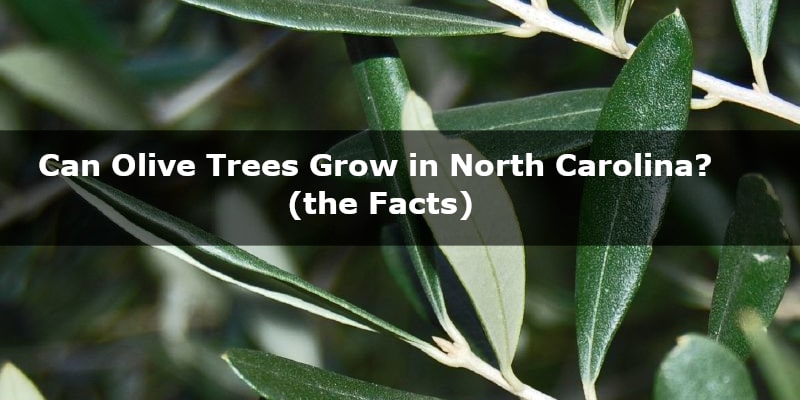If you live in North Carolina, you might wonder if it’s possible to grow olive trees here.
After reading this article, you will find it out!
Can Olive Trees Grow in North Carolina?
Olive trees can grow in North Carolina, but only in climate zones 8a and 8b. You should opt for cold-hardy varieties like Arbequina, Ascolana, or Mission.
Olive trees thrive in warmer climate zones. However, if you choose a cold-hardy variety, you can successfully grow an olive tree in the eastern parts of North Carolina.
Keep on reading to find out which variety to choose, and where exactly you can plant your olive tree.
What Zones Can Olive Trees Grow in?
Olive trees grow best in climate zones 10 and 11. They can also grow in zones 8 and 9, but crops are usually less abundant.
Olive trees thrive in a subtropical climate where winters are mild and long, and summers are warm and dry. They are sensitive to hard freezing environments. Therefore, they will grow best in climate zones 10 and 11. Hardy varieties might also grow in zone 9 or even 8. It’s very unlikely that an olive tree will grow in a zone lower than 8.
Temperatures below 22ºF (-5ºC) will kill small wood and branches. Freezing conditions lasting days or a hard freeze, below 15ºF (-10ºC), will kill or severely damage an olive tree. It is best to avoid planting olive trees in situations where there is a high risk of frost during bloom or where freezing conditions are likely before harvest.
In Which Parts of North Carolina Can Olive Trees Grow?
It’s possible to grow olive trees in North Carolina in climate zones 8a, and 8b, which is on the east, southeast, and northeast side of the state.
North Carolina growing zones range from 5b to 8b. Most of North Carolina’s climate is a humid subtropical climate with the exception of the Appalachians, which have a subtropical highland climate.
The North Carolina mountain ranges across the state keep the storms and extreme low temperatures from the Midwest from impacting it too much. Midsummer temperatures average in the 90s, whereas average winter temperatures are generally in the 50s.
The climate is affected by the Atlantic Ocean and the Gulf Stream, which allows for warmer winter temperatures in the coastal parts of the state. In those coastal regions, winter temperatures rarely drop below freezing. Therefore, it’s possible to grow olive trees in the east of the state.
You can grow olive trees near eastern cities like New Bern, Wilmington, Kinston, and Greenville.
On the map below, you can see North Carolina growing zones. The 8a, and 8b zones are the zones where olive trees can grow.

What is the Most Cold-Hardy Olive Tree?
Because olive trees grow best in zone 10, and 11, if you intend to grow them in zone 9 or 8, you need to choose a hardy variety that will do best in colder climates. Cold-hardy varieties ensure good yields. Here are the most recommended cold hardy varieties.
- Arbequina
- Ascolana
- Mission
- Sevillano
- Aglandau
- Barouni
- Cornicabra
- Farga
- Hojiblanca
- Leccina
- Maurino
- Pendolino
- Picudo
- Picual
Many of these are used for commercial oil production and are not available widely for home planting, but Arbequina, Ascolana, Mission, and Sevillano are obtainable. Some varieties are self-fertile, but others need cross-pollination with another variety.
How to Grow Olive Trees in North Carolina?
Planting
The best time to plant is in spring, after the danger of frost passed. Fall planting should only be done in areas where winter temperatures do not fall below 30° F (-1 °C). Plant in a place where your tree will get 8 or more hours daily. Do not plant in low areas where standing water accumulates.
Most olive trees are self-fertile. However, you’ll often increase fruit yields by planting a tree of another variety nearby and allow them to cross-pollinate.
Care
Olive trees are drought tolerant once established, but for good flowering and fruit development, you should water them regularly throughout the growing season. Water newly planted trees deeply two or three times a week in the spring and summer.
Established trees can be watered every few weeks. In the fall and winter, you shouldn’t water your olive tree.
When it comes to soil, any well-drained soil is acceptable. Do not plant in heavy clay soils. If the soil is poor, feed the tree with a well-balanced fertilizer with a nitrogen content of at least 10 percent.
Olive trees respond well to pruning. To keep your tree healthy, also remove dead or diseased branches and prune away any suckers that develop at the base of the tree.
You can harvest olives while they are still green or after they fully ripen in late fall, depending on how you plan to use them.
Growing Indoors
Growing your tree in a container that you can move indoors might be a great option. Here are tips for growing an olive tree successfully indoors:
- Place it in a spot where it will receive at least 6 hours of sunlight a day.
- Choose a dwarf olive tree variety that won’t grow taller than 6 feet (180 cm). You can prune your tree, if necessary.
- Plant your tree in a large container with good drainage, and use a potting soil mix that drains easily, such as this one on Amazon.
- Apply a slow-release fertilizer twice a year, in spring and mid-summer.
- Before moving your tree outdoors again in spring, wait until all danger of frost has passed and allow it to acclimate by gradually exposing it to more sunshine.
Sources
oliveoilsource.com, gilmour.com, gardeningknowhow.com, homeguides.sfgate.com, gardendesign.com


